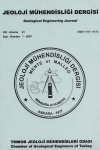
ABSTRACT: In this study, stratigraphical position of metaophiolite (metadunite, amphibolite/metagabbro) of Kazdağ Massive (Balıkesir) is determined and they are examined for their titanium contents. Metaophiolite in Kazdağ Massive, composed of high-degree metamorphic rocks (amphibolite facies), are called as Tozlu Formation. This unit contains metadunites, amphibolites and metaperidotites and overlain by Fındıklı Formation, composed of amphibole gneiss and marble sequence, with a tectonic contact. Sarıkız Formation which is formed by marbles, comes over Tozlu Formation with a conformable boundary and overlain by Sütüven Formation, which is dominantly composed of gneisses. Titanium ores have primary and secondary bedding types. The important rock types for the primary beddings are anorthosite, gabbro and norite. The source of amphibolites in Tozlu Formation is originated from gabbroic rocks on the bases of fieldwork and mineralogical petrographical methods. Under this scope, ore microscopy of samples are studied. In addition, in order to obtain the titanium content in the study area 23 samples are objected to chemical analyses. The result of these analyses and the relationship of titanium with other elements; Fe, Co, Cr, Ni, Cu and Zn; are discussed and evaluated. As a result of mineralogical and petrographical studies and chemical analyses, the area of Kazdağ metaophiolite do not seem encouraging for titanium mineralization under todays conditions.
ABSTRACT: In the method of rotary drilling used in investigations of natural gas, petrol, geothermal souces and natural CO2, one of the problems encountered during progress is the problem of gushing (evacuation) problem. In order to prevent this mostly encountered problem in such drillings, no: S-1 Yakatarla (Nevsehir Gulsehir) Carbon dioxide investigation drilling is chosen as pilot drilling and the detection of possible gushing problem and necessary technique precaution options for the application of this problem serve as the aim of this study. The stop of gushing problem of no: S-1 drilling is to prevent slumpingcollapse in well, continue drilling by applying suitable isolation processes and to enable the completion of the well. In the no: S-1 drilling well built in discordant alluvium on upper Miocene-Pliocene aged Tuzkoy formation, considering the formation to be sheared and underground water level, bored with 0-36 m. 15 1/2 drill, 0 to 30 m.; the outer of pipe 10 and inner part of 1 m. pipe in base part cemented as 1. isolation (1,8 gr/cm3, 3 m3) and 1.46 m3 displacement fluid is used. Then, 29 to 60m. is bored with 9 5/8 drill and 0 to 60m. the outer of 8 pipe (approximately 0,5 m3), inner part of 5m. pipe in base part and the field discharged by gushing (approximately 3,5 m3) is cemented as 2. isolation (1,9 gr/cm3, 4 m3) and 1,51 m3 displacement fluid is used. Moreover, 60 to 74m. is bored with 7 5/8 drill against collapse and 0 to 74m. is made 3. isolation without being cemented because of squeezing with pipe. The first sand gushing in the well occurred between 50-60m. the problem is prevented by mass mud and 2. isolation process. Later on, advancing along 60-90m. with 7 5/8drill gushing is experienced again but the free-weight of drilling mud between 60-90m. could not prevent gushing and gas burst. During gushing, fine grained yellow/green sand approximately 5 m3, CO2 gas and haline water outlet are observed. In order for the well to advance safely considering the pressured applied by mud on the well and gushing pressure, new mud of barite (125 kg.) + bentonite (250 kg.) + cement (250 kg.) + clay 3 m3 mixture is prepared. Gushing is decelerated by the new mixture, gushing in the well is completely stopped by reaming process in well, advancement is sustained by keeping this rate till the completion of well. First of all 66 to 74m. has swelled too much. Advancement is sustained in high swelling featured clay stone between 90-145m., sandstone between 145-158m., clay stone between 158-170m., clay stone banded sandstone between 170-180m. and the well is stopped in clay stone between 180-205m. The equip is in the shape of 0-36m. close, 36-40m. filtered pipe. 7 ½ sleeve is fixed between upper 4. and 5. pipes. As a result of the study, it is put forward that in order to prevent gushing in drillings planned in the area the mud density should be above 1,8-1,9 (gr/cm3), and in order to carry isolation process easily; the diameter of the well start should be as wide as 22 or 25.
ABSTRACT: The aim of this study was to determine the mineralogical and geochemical properties of the rocks and/or soils consumed for making grape molasses and "eating" which is called geophagy. For this purpose 12 samples were collected from the regions of Niğde Bor, Ulukışla and Aksaray-Emirgazi and full rock analyses were carried out including XRD. As a result; clay, mica, carbonate (calcite, dolomite), cristobalite, amphibole, quartz, feldispar and opal-CT minerals were detected. Elemental and trace element analyses were carried out on all samples. Elemental analyses results showed that elements such as CaO+Al2O+Fe2O3 in Bor; CaO+Si2O+Fe2O3 in Ulukışla; CaO+MgO in Emirgazi regions were dominant. According to trace elemet analyses, concentrations of Sr, Ba, Ce, Zn and As in Bor; U, Ce, Ba, Zr, Sr, Ni in Ulukışla and Ba, Sr, La, Ce, Co, Zr elements in Emirgazi regions drew attention. As a result of these analyses we can say that all samples are lacustrine sediments that are claystone, travertine and dolomite and Neogene aged.

 TMMOB
TMMOB